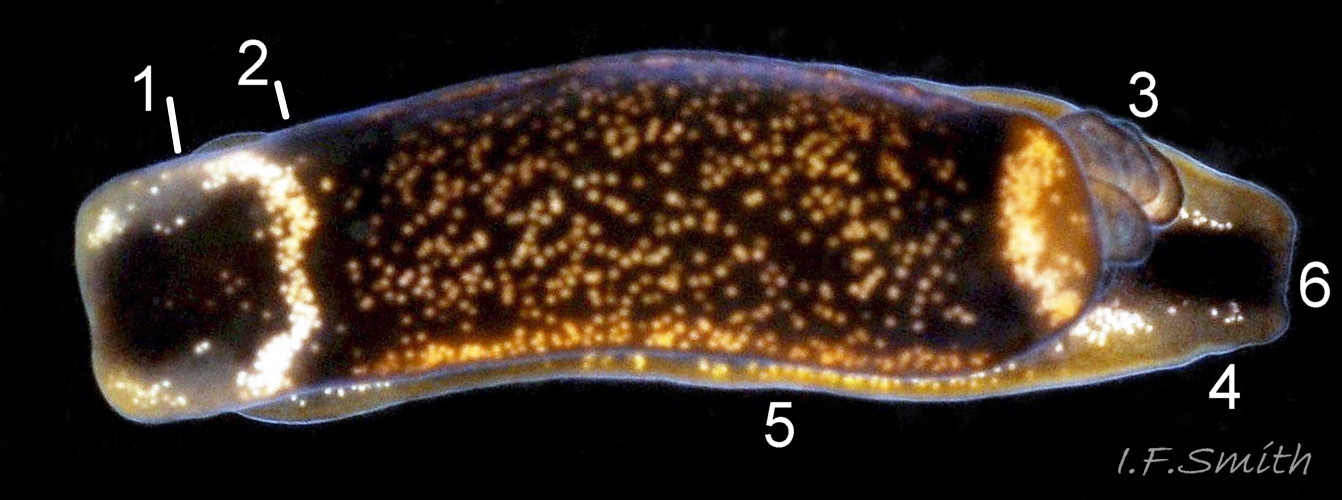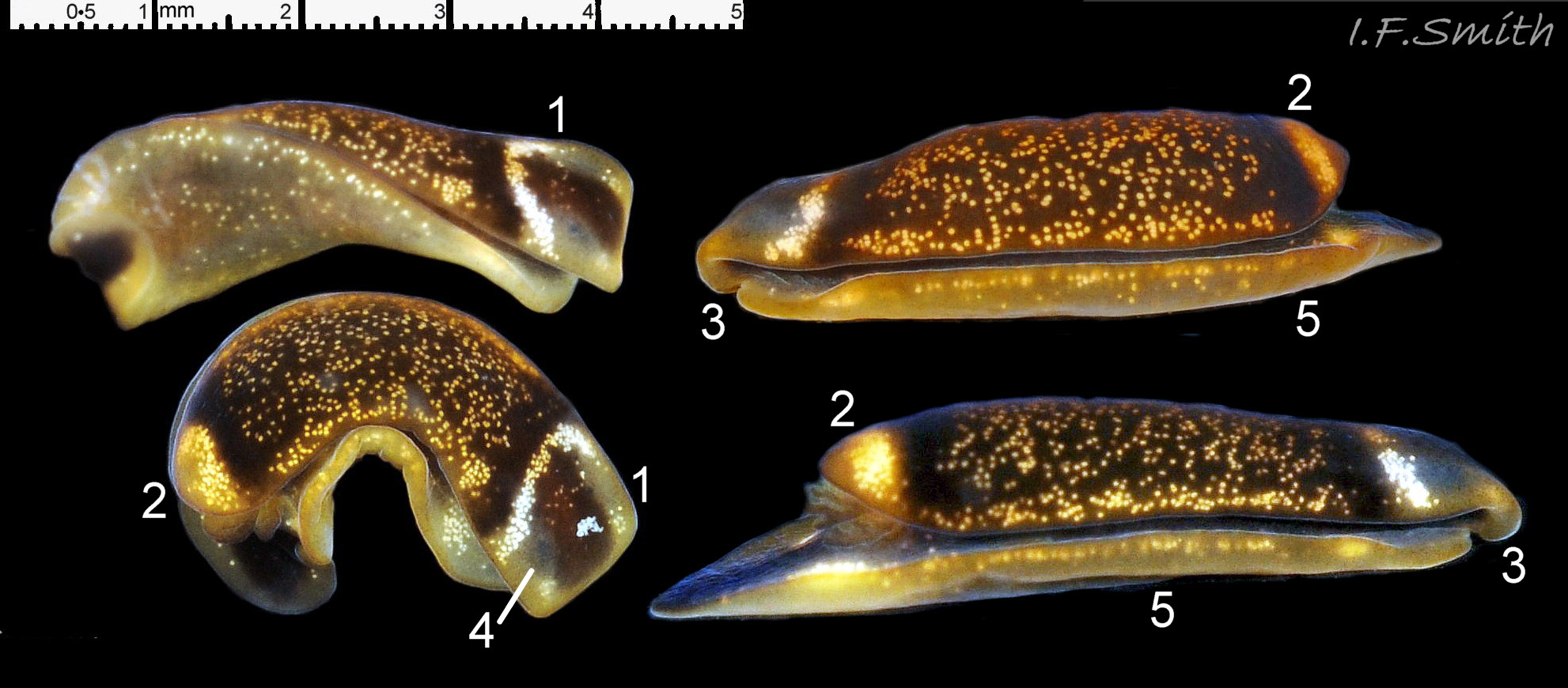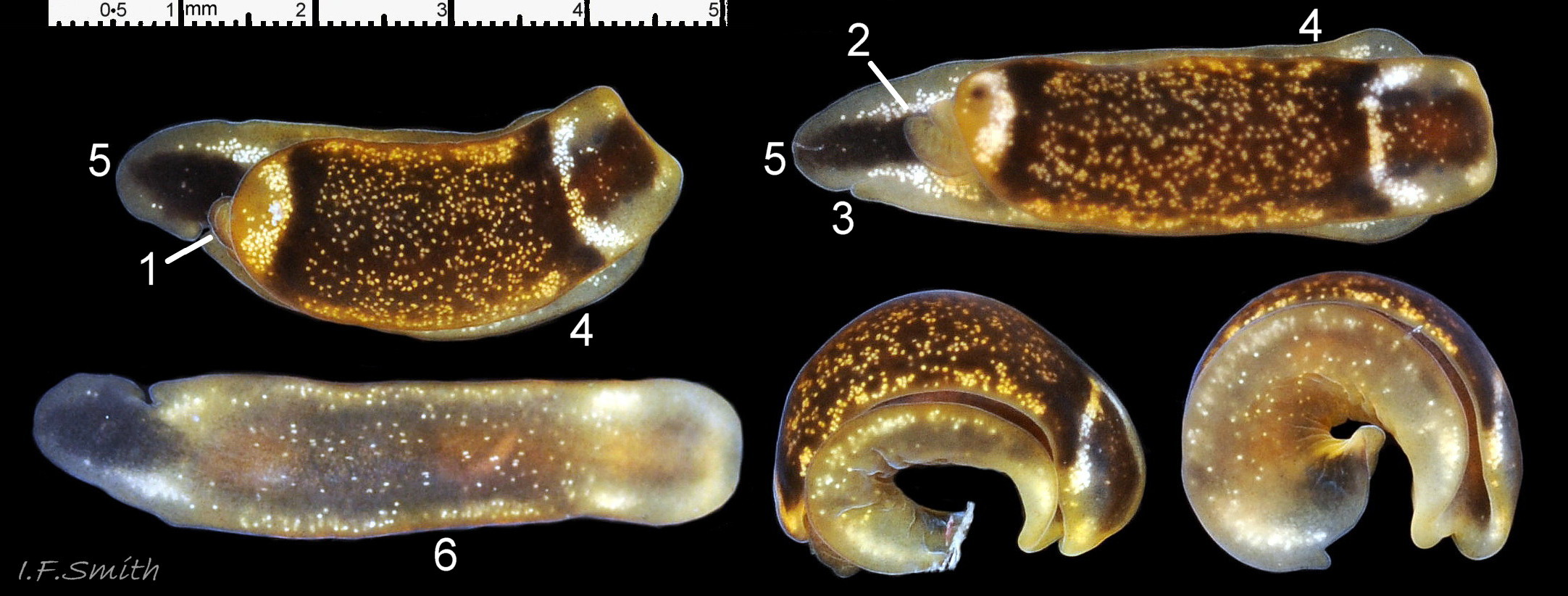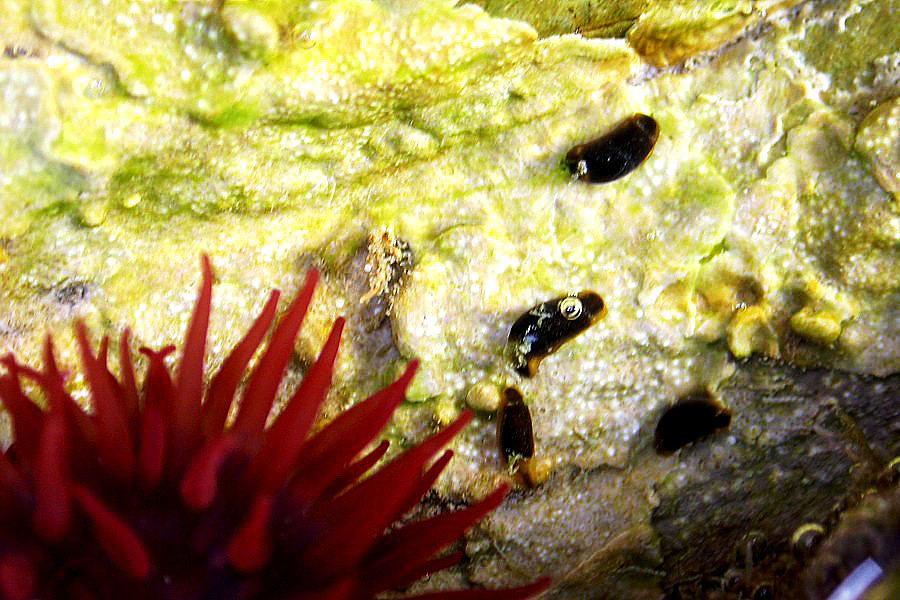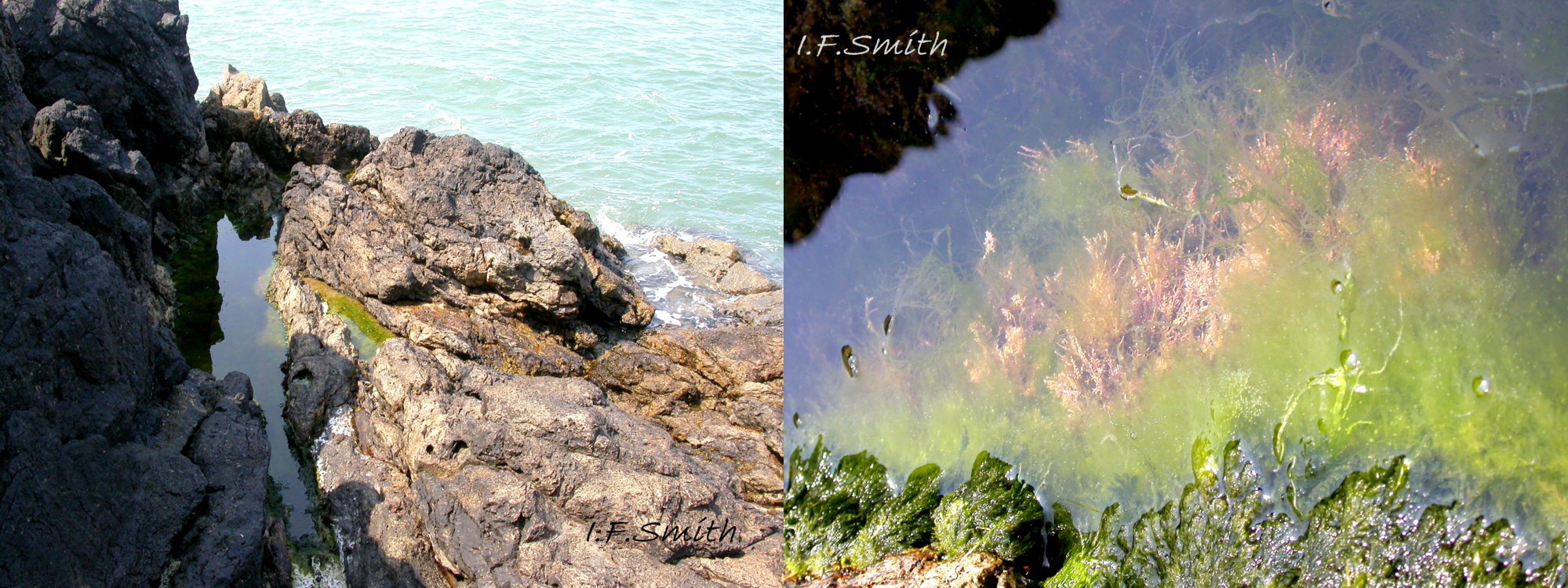Click image to enlarge with full caption. Main text below slider.
Runcina coronata (Quatrefages, 1844)
PDF available at www.researchgate.net/publication/351152308_Runcina_corona…
Current taxonomy; World Register of Marine Species www.marinespecies.org/aphia.php?p=taxdetails&id=141411
Synonyms:Pelta coronata Quatrefages, 1844; Runcina hancocki Forbes [in Forbes & Hanley], 1851; Ossiania alata (Forbes 1844); Philine pusilla M. Sars, 1859.
GLOSSARY below.
Shell
R. coronata has no trace of a shell at any stage of development.
Body description
The body, up to 6.5 mm long, is an oblong four times as long as wide when fully extended ( 01 Runcina coronata). Its surface is smooth with no tentacles or tubercles. The head is concealed below a rectangular cephalic shield which is fused to the mantle. The anterior of the shield is frequently folded down over the front of the foot ( 02 Runcina coronata. Sometimes, small black eyes are faintly visible through the shield.
When seen on the shore (fig 3 03 Runcina coronata), R. coronata usually appears black or pitchy brown with a whitish collar and a few light marks. In strong lighting, such as photographic flash, dorsally the body is black or brown with a whitish border around the cephalic shield, many yellow spots on the mantle, and yellow and white on the posterior of the mantle ( 01 Runcina coronata & 02 Runcina coronata). The anus is under the rear edge of the mantle; white faeces (03 Runcina coronata) are often visible on the adjacent foot when it is grazing on calcareous Lithothamnium.
A tuft of three brown, simple gills may protrude from below the posterior of the mantle on its right side (01 Runcina coronata & 03 Runcina coronata), but protrusion can be slight and the gills go unnoticed ( 04 Runcina coronata).
The foot is distinct ( 02 Runcina coronata) from the fused mantle/cephalic shield. The metapodium usually extends well beyond the posterior of the mantle (01 Runcina coronata & 04 Runcina coronata), and it may protrude a little laterally into dorsal view. It has a broad, medial, black-brown band flanked by a few white spots and wide paler periphery. The sole is whitish with opaque white spots. Because it is translucent, the colours of the viscera and the dark dorsal colours show through it ( 04 Runcina coronata).
Key identification features
R. coronata
1) Body predominantly brown or black.
2) Head concealed under rectangular cephalic shield ( 01 Runcina coronata).
3) Cephalic-shield is fused to mantle with a white or yellowish band on the fusion line.
4) No tentacles, ribs or crests on anterior. Eyes are very faintly visible or not at all.
5) Extensive metapodium with broad, medial, dark band protrudes at posterior
(figs. 1 01 Runcina coronata & 4 04 Runcina coronata).
6) Tuft of brown gills often protrudes on right from under posterior edge of mantle
(figs. 1 01 Runcina coronata & 3 03 Runcina coronata).
Similar species
Limapontia senestra (Quatrefages, 1844), Limapontia capitata (O. F. Müller, 1774) and Limapontia depressa Alder & Hancock, 1862 ( 05 Runcina coronat).
1) Body predominantly brown or black.
2) Head not concealed under a cephalic shield.
4) Have head tentacles, crests or ribs and distinct eyes in pale patches.
6) No tuft of gills.
Philine punctata (J. Adams, 1800) ( 06 Runcina coronata)
1) Body predominantly brown.
2) Head concealed under cephalic shield; not fused to mantle.
3) Cephalic shield distinct from and not fused to mantle.
4) No tentacles, ribs or crests on anterior and eyes not visible.
5) Foot extends into lateral parapodial lobes, no protrusion of metapodium at posterior.
6) No exposed tuft of gills.
7) Widespread but overlooked in Britain.
Runcina ferruginea Kress, 1977 ( 07 Runcina coronata)
1) Body red.
2) Head concealed under cephalic shield.
3) Cephalic-shield is fused to mantle with no indication of fusion line.
4) No tentacles, ribs or crests on anterior. Eyes are very faintly visible or not at all.
5) Extensive metapodium, without a medial band, protrudes at posterior.
6) Tuft of red gills may protrude on right from under posterior edge of mantle.
7) Southern species, recently found in south-west Britain; Cornwall, Devon, Dorset and in south-west Ireland.
Other spp. of Runcina
In Iberia and the Mediterranean, there are more species of Runcina which may be confused with R. coronata (Cervera et al.1991, Cervera in Rudman, and Furfaro et al. 2020).
Habits and ecology
R. coronata lives on rocks and algae at all littoral tide levels and sublittorally. It may be abundant in rock pools lined with encrusting calcareous Lithothamnion algae where its dark colour allows easy detection against the pale substrate ( 08 Runcina coronata habitat. ). It may occur plentifully in such pools at and above mean high water spring tide level at sites exposed to very strong wave action such as the tip of Portland Bill, Dorset and, on Corallina, the north coast of Anglesey ( 09 Runcina coronata habitat. ). It also occurs on algae in shallow water at LWS of lagoons and very sheltered land-locked bays such as Finstown, Orkney, and in pools near LWS among Chondrus crispus and Rhodochorton algae.
Its apparent absence from the North Sea and north-east Irish Sea suggests it cannot survive the winter temperatures which are lower there than on other British coasts. With climate change, it may yet spread into the North Sea. It occurs in fully marine salinity and brackish conditions, and is able to withstand fluctuations in salinity as it occurs in rock pools which are not refreshed with sea water at every high tide and are subject to salinity change from rainfall and evaporation.
When grazing on the surface of Lithothamnion, white faeces ( 03 Runcina coronata) suggest it ingests some of it, perhaps obtaining nutrition from it as well as from diatoms and other microscopic organisms living on its surface. Its survival in high numbers while highly visible against pale Lithothamnion suggests it has repugnatory substances in its body.
R. coronata is hermaphrodite. In spring, it produces spawn masses of up to 30 large ova (diameter 0.3 mm). There is no free veliger larval stage; miniature adults hatch from the eggs.
Distribution and status
R. coronata is found from Shetland (Fair Isle) to the Mediterranean, GBIF map www.gbif.org/species/5190026 . It is widespread and locally common, though often overlooked because of its small size, around Ireland and on south, west and north coasts of Britain. It is apparently absent from the North Sea (Caithness to Sussex) and north-east Irish Sea; NBN UK map species.nbnatlas.org/species/NBNSYS0000177754 .
Acknowledgements
I thank David Fenwick, www.aphotomarine.com/ for use of his images of R. ferruginea.
References and links
Barnes, R.S.K., 1994. The brackish-water fauna of northwestern Europe. Cambridge.
Cervera, J. L., Garcia Gomez, J. C. and Garcia, F.J. 1991. The Genus Runcina Forbes and Hanley, 1851 (Opisthobranchia: Cephalaspidea) in the Strait of Gibraltar, with the Description of a New Species from the Bay of Algeciras . Journal of Molluscan Studies 57 (Supplement Part 4):199-208. www.researchgate.net/publication/259007487_The_Genus_Runc…
Furfaro, G., Vitale F., Licchelli, C. and Mariottini, P. 2020. Two Seas for One Great Diversity: Checklist of the Marine Heterobranchia (Mollusca; Gastropoda) from the Salento Peninsula (South-East Italy). Diversity 12:171 www.researchgate.net/publication/340933406_Two_Seas_for_O…
Rudman, W.B. Sea Slug Forum
Thompson, T.E. 1976. Biology of opisthobranch molluscs 1. London, Ray Society.
Current taxonomy; World Register of Marine Species www.marinespecies.org/aphia.php?p=taxdetails&id=141411
Glossary
cephalic= (adj.) of or on the head.
cephalic shield = shovel-like layer covering head of philinid sea slugs.
mantle = sheet of tissue covering visceral mass of molluscs. Secretes shell of shelled species, and forms part or all of dorsal body surface (notum) of those without shells.
medial = midline of body or organ.
metapodium = hind part of the foot.
parapodial lobes = flaps which extend from the foot up the sides of some sea slugs.
veliger = shelled larva of marine gastropod or bivalve mollusc which swims by beating cilia of a velum (bilobed flap).
